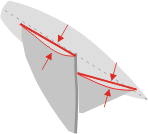Here is a rough set-up for the IOM No.1 rig when close-hauled.
| |
|
[Technical] |
 |
Main sail sheeting angle: Get the tip of your thumb between the
sheeting post and the boom.
|
5 degrees |
| Jib sheeting angle (slot): Make sure you can stick the ends of four
fingers between the jib boom and the mast (three if you have thick fingers). |
12 degrees |


|
Main sail twist: Have the middle main batten parallel with the boat
centre-line, the lower batten pointing in a little, and the upper batten falling
off some. Peter Spence suggests having the top
batten falling off the same amount as the main boom sheeting angle -- that is,
have it parallel with the boom. Make this setting without wind in the
sails; when sailing, the leech will open up as necessary. |
7.5 to 10 degrees |


|
Jib twist: Have the gap between the leech and the topping lift take at
least two fingers.
Or, like the mainsail, have the upper batten parallel with the jib boom.
|
10 to 12.5 degrees |
 |
Mast bend (mast ram): Set the mast curve to nicely match the main luff
curve, then straighten the mast a smidgen (OK, maybe 3 mm) to push fullness into
the middle of the sail if the wind is lighter than "top of No.1". |
|


|
Jibstay tension: Make sure the jibstay never flaps in the breeze. (If
you take this seriously, you'll have to have mast pre-bend to obtain the
necessary backstay tension. Or, set your shrouds
well aft of the mast and use a "V" spreader.) |
|
 |
Main draft (outhaul): Get at least a finger and a half between the foot of the
main and the boom, up to two fingers. |
8% |
| Jib draft (outhaul): Get at least a finger between the foot of the jib and the boom,
up to a finger and a half, but two fingers might be a bit too much. |
6% |
 |
Jib pivot: Somewhere around 25% of the jib foot, less if you have
achieved high jibstay tension. |
20% - 25% |
 |
Sheeting radius: Make sure the jib boom sheeting radius (distance
between pivot point and jib sheet attachment point) is around 10% longer than
the main boom sheeting radius (distance between gooseneck pivot axis and main
sheet attachment point). |
|
